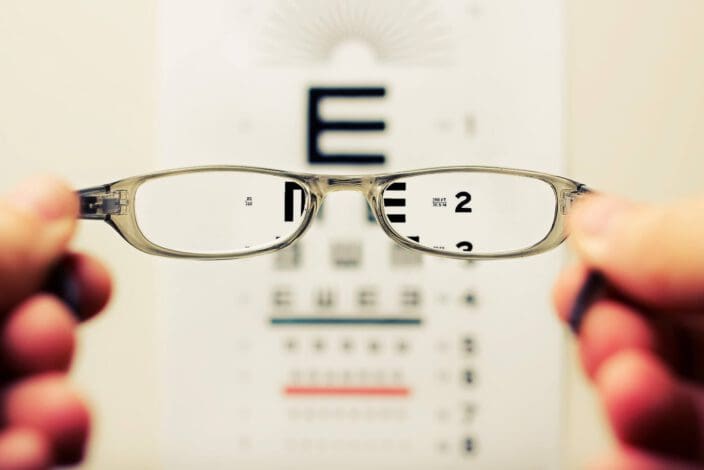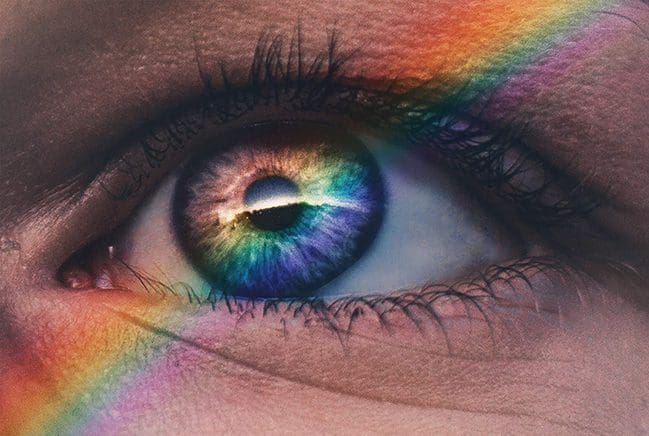Distorted Vision: What It Means & How to Treat It
Home / Eye Conditions & Eye Diseases /
Last Updated:
Distorted vision is an eye condition that makes straight lines appear wavy and objects appear bent or misshapen. It can be challenging to live with, as regular objects are difficult to identify and see clearly.
Table of Contents
There are many possible causes of distorted vision, such as eye disease, damage to the eye, or eye infection and inflammation. Identifying the cause of your distorted vision is an important step in finding the correct treatment.
Distorted vision is often a symptom of a greater eye problem. For people who are experiencing distorted vision, it could be an indicator that an associated eye disease is present.
There are certain health and lifestyle factors that increase your risk of developing a condition that causes distorted vision. Smoking, poor diet, and lack of exercise can all contribute to developing related eye problems. Identifying and reducing your risk factors can greatly improve your ability to maintain healthy eyesight for the long term.
Treatment options for distorted vision vary based on what is causing the symptom. Depending on your eye condition, you may be able to treat your distorted vision at home by wearing eyeglasses or contact lenses. Other conditions may require medical treatment or surgical intervention.
There are a number of prevention methods to incorporate into your daily life in order to reduce your chances of developing a condition that causes distorted vision. Getting routine eye exams that lead to early detection and treatment of eye problems is one of the best ways to prevent distorted vision.
What Is Distorted Vision?

The American Academy of Ophthalmology (AAO) defines distorted vision as a condition in which familiar objects look wavy or bent incorrectly. Lines that should be straight may appear bent or crooked, and it is difficult to see objects clearly.
Distorted vision can also be described as a visual illusion where objects appear warped. Objects may appear out of shape, or larger or smaller than they should. Some people describe distorted vision as making things look like a Picasso painting.
You deserve clear vision. We can help.
With 135+ locations and over 2.5 million procedures performed, our board-certified eye surgeons deliver results you can trust. Your journey to better vision starts here.
Causes of Distorted Vision
Many different conditions can lead to distorted vision. Common causes include:
- Damage to the macula.
- Retinal damage or detachment.
- Ocular trauma.
- Inflammation in the eye.
- Lesions on the retina or visual cortex.
- Visual or retinal migraine.
Ophthalmologists from the Kellogg Eye Center at the University of Michigan note that some situations can cause a person to think they have distorted vision, though they actually do not. For example, new glasses that have been prescribed to correct for an astigmatism may create an illusion of distorted vision until the patient’s eye adjusts to the new prescription or the prescription of the glasses is altered. Likewise, scotomas (blank or dark spots in your vision) are occasionally reported by patients as distorted vision, though this is actually a different condition.
Associated Problems
According to AAO, there are many eye problems that can be associated with distorted vision, such as irregularities on the cornea or retina.
Some of the eye conditions that can cause distorted vision include:
- Age-related macular degeneration (AMD). AMD occurs when the macula, a part of the retina, is damaged. You lose central vision and cannot see fine details.
- Astigmatism
This refers to an imperfection in the curvature of your cornea or lens that causes near and far objects to appear blurry or distorted. - Pink eye (conjunctivitis): When the conjunctiva in the eye becomes red and swollen due to an infection or allergies. This inflammation can cause hazy or blurred vision.
- Keratoconus: When the cornea thins and bulges outward. It causes blurry and distorted vision.
- Macular edema: Macular edema is caused by fluids that build up in the macula and cause it to swell, which can distort vision.
- Macular hole: Caused by a tear or opening in the macula, a macular hole causes objects in your central vision to appear distorted, blurry, or wavy.
- Macular pucker: When the macula, which normally lies flat against the back of your eye, wrinkles, folds, or bulges, your central vision is impaired. Objects appear distorted or blurry. In some cases, you cannot see objects.
- Retinal vein occlusion (RVO): When a vein blockage prevents blood from properly circulating to the back of the eye, blurring and distortion of your central vision can occur.
You deserve clear vision. We can help.
With 135+ locations and over 2.5 million procedures performed, our board-certified eye surgeons deliver results you can trust. Your journey to better vision starts here.
Risk Factors for Distorted Vision

Lifestyle choices can increase or decrease your risk of developing eye problems that lead to distorted vision. Smoking, diet, and exercise all impact eye health. High blood pressure and high cholesterol are associated with AMD, RVO, and diabetic macular edema (DME), a specific kind of macular edema that people with diabetes are at risk of developing.
Serious cardiovascular conditions can also be seen by eye doctors as they examine the back of patients’ eyes during routine eye exams. Through eye screenings, some risk factors for larger health issues can be identified and treated. Many eye doctors will work with their patients to address the risk factors in their lives before starting medical treatment.
Alcohol, Drugs and Distorted Vision
Drugs and alcohol use can have adverse effects on the health of your eyes, leading to short-term and long-term damage. Chronic use of alcohol and drugs can slow the communication between the eyes and the brain, leading to blurred or distorted vision. By limiting interactions between the brain and eyes, alcohol can impair your ability to distinguish between different color shades and reduce the pupils’ reaction to stimuli.
Excessive drinking long-term can lead to vision loss, especially in people who combine their drinking with smoking and a consistently poor diet. Known as tobacco-alcohol amblyopia, this condition is classified as optic neuropathy. It can also lead to reduced color vision and decreased peripheral vision.
In both the short and long term, alcohol affects the optic nerve and the communication pathways between the brain and the eye, leading to distorted vision. Alcohol consumption also contributes to AMD, which affects the central part of the retina that is responsible for clear, sharp vision.
Smoking, diet, and exercise can all impact eye health. Conditions such as high blood pressure and high cholesterol are associated with AMD, RVO and diabetic macular edema. It’s possible for ophthalmologists to diagnose serious cardiovascular conditions as they examine the back of a patient’s eyes.
Treatment Options for Distorted Vision
Fortunately, most cases of distorted vision are treatable. Outcomes vary, depending on the cause of the distortion and the patient’s response to treatment.
Various eye problems that cause distorted vision are treated in different ways.
- Astigmatism: Eyeglasses, contact lenses, LASIK, or other laser vision correction procedures are used to correct vision.
- Conjunctivitis: Prescription eye medication is given to resolve the issue.
- Macular degeneration: Sunglasses, dietary supplements (vitamins A, C, E, and zinc), vision rehabilitation, photodynamic therapy, and macular degeneration therapies are all used.
- Keratoconus: Treatment includes rigid contact lenses, eyeglasses, and corneal transplantation.
- Macular hole: A vitrectomy is the primary treatment.
- Retinal detachment: Treatment includes retinal detachment surgery, vitrectomy, and laser photocoagulation.
- Migraine: Relaxation techniques, lifestyle and dietary changes, and medications are often recommended.
The treatment approaches for distorted vision vary greatly depending on what is causing the visional distortions. In some cases, at-home solutions (such as wearing sunglasses, taking vitamin supplements, and eliminating risk factors) may be enough to treat mild cases of visual distortion. In other cases, medical intervention may be required, such as with conjunctivitis or a retinal detachment.
Doctors may also advise taking certain supplements, such as vitamins C and E, lutein and zeaxanthin, to improve your vision. Distorted vision can also be prevented and improved by making healthy lifestyle choices such as eating a healthy diet, reducing alcohol intake, and eliminating smoking.
Any sudden change in vision is a concern that should be addressed as soon as possible. If you notice distorted vision, kindly consult with your eye doctor. As with many health issues, earlier detection and treatment result in a better outcome.
Prevention Methods

AAO explains that many people do not realize they have an eye disease because there are few or no warning signs. Many people assume that vision problems are a part of aging and fail to get proper eye care. Early detection and treatment of eye problems, however, can prevent many cases of blindness and vision loss.
In order to maintain healthy vision throughout your life, AAO recommends that all adults (even people with no signs or risk factors for eye problems) get a general eye screening at age 40. People of any age with risk factors for eye disease should meet with an ophthalmologist to establish a regular eye screening schedule.
Eye disease and vision loss impact millions of Americans, explains the National Eye Institute (NEI). Most vision problems can be prevented by regularly using eye protection and making healthy lifestyle choices. Make regular eye exams a priority.
You deserve clear vision. We can help.
With 135+ locations and over 2.5 million procedures performed, our board-certified eye surgeons deliver results you can trust. Your journey to better vision starts here.
References
- Distorted Vision. (December 2015). American Academy of Ophthalmology.
- Distorted Vision (Metamorphopsia). Kellogg Eye Center: University of Michigan.
- Conditions and Treatment: Distortion. UCLA Stein Eye Institute.
- Healthy Vision Resources. (July 2019). National Eye Institute.
- If You Suffer From Blurry or Distorted Vision It’s Time to See Your Eye Doctor. The International Federation on Ageing via Personal Health News.
- Metamorphopsia: An Overlooked Visual System. (November 11, 2015). Ophthalmic Research.
- Macular Hole. (July 8, 2019). National Eye Institute.
- Age-Related Macular Degeneration (AMD) Data and Statistics. (July 17, 2019). National Eye Institute. Date fetched: July 16, 2021.
- Ocular Manifestations of Drug and Alcohol Abuse. (August 22, 2015). National Library of Medicine.
- Tobacco-alcohol amblyopia: a maculopathy? (November 2005). British Journal of Ophthalmology.
This content is for informational purposes only. It may have been reviewed by a licensed physician, but is not intended to serve as a substitute for professional medical advice. Always consult your healthcare provider with any health concerns. For more, read our Privacy Policy and Editorial Policy.